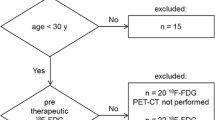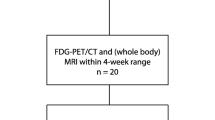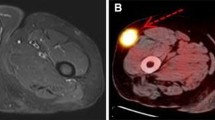Abstract
Purpose
To evaluate the diagnostic accuracy of 18F-FDG PET/CT for detecting recurrence in patients with primary skeletal Ewing sarcoma.
Methods
We retrospectively analysed data from 53 patients (age 20.1 ± 10.5 years, 39 male) who had undergone 71 18F-FDG PET/CT studies for suspected recurrence (52 studies) or for routine follow-up (19 studies) after primary therapy of skeletal Ewing sarcoma. 18F-FDG PET/CT studies were evaluated qualitatively and quantitatively (maximum standardized uptake value, SUVmax) by two nuclear medicine physicians in consensus. Sensitivity, specificity, predictive values and accuracy were calculated on per study basis. Clinical/imaging follow-up (minimum 6 months) and/or histopathology (when available) were taken as the reference standard.
Results
Of the total of 71 18F-FDG PET/CT studies, 42 (59.1 %) were positive for recurrence and 29 (40.9 %) were negative for recurrence. Local recurrence was most common (38 studies) followed by bone metastasis (9 studies), and node and lung metastasis (2 studies each). Of the 71 studies, 38 were true-positive, 27 were true-negative, 4 were false-positive and 2 were false-negative. Overall per study based sensitivity was 95 %, specificity was 87 %, PPV was 90 %, NPV was 93 % and accuracy was 91.5 %. No significant difference was found in the accuracy of PET/CT between the suspected recurrence group and the routine follow-up group (94 % vs. 84 %; P = 0.390). Overall mean lesion SUVmax was 7.8 ± 4.1 (range 1.9–17.2). No site-based difference was found in SUVmax.
Conclusion
18F-FDG PET/CT demonstrates high diagnostic accuracy for detecting recurrence in patients with primary skeletal Ewing sarcoma, when it is suspected (clinically or on imaging) or during routine follow-up.




Similar content being viewed by others
References
Heare T, Hensley MA, Dell’Orfano S. Bone tumors: osteosarcoma and Ewing’s sarcoma. Curr Opin Pediatr. 2009;21:365–72.
Hawkins DE, Bölling T, DuBois SG, et al. Ewing sarcoma. In: Pizzo PA, Poplack DG, editors. Principles and practice of pediatric oncology. Philadelphia: Lippincott Williams & Wilkins; 2010. p. 987–1014.
Esiashvili N, Goodman M, Marcus Jr RB. Changes in incidence and survival of Ewing sarcoma patients over the past 3 decades: Surveillance Epidemiology and End Results data. J Pediatr Hematol Oncol. 2008;30:425–30.
Wasilewski-Masker K, Liu Q, Yasui Y, Leisenring W, Meacham LR, Hammond S, et al. Late recurrence in pediatric cancer: a report from the Childhood Cancer Survivor Study. J Natl Cancer Inst. 2009;101:1709–20.
Rodriguez-Galindo C, Billups CA, Kun LE, Rao BN, Pratt CB, Merchant TE, et al. Survival after recurrence of Ewing tumors: the St. Jude Children’s Research Hospital experience, 1979–1999. Cancer. 2002;94:561–9.
Reuther G, Mutschler W. Detection of local recurrent disease in musculoskeletal tumors: magnetic resonance imaging versus computed tomography. Skeletal Radiol. 1990;19:85–90.
Treglia G, Salsano M, Stefanelli A, Mattoli MV, Giordano A, Bonomo L. Diagnostic accuracy of 18F-FDG-PET and PET/CT in patients with Ewing sarcoma family tumours: a systematic review and a meta-analysis. Skeletal Radiol. 2012;41:249–56.
Franzius C, Daldrup-Link HE, Wagner-Bohn A, Sciuk J, Heindel WL, Jürgens H, et al. FDG-PET for detection of recurrences from malignant primary bone tumors: comparison with conventional imaging. Ann Oncol. 2002;13:157–60.
Charest M, Hickeson M, Lisbona R, Novales-Diaz JA, Derbekyan V, Turcotte RE. FDG PET/CT imaging in primary osseous and soft tissue sarcomas: a retrospective review of 212 cases. Eur J Nucl Med Mol Imaging. 2009;36:1944–51.
Gerth HU, Juergens KU, Dirksen U, Gerss J, Schober O, Franzius C. Significant benefit of multimodal imaging: PET/CT compared with PET alone in staging and follow-up of patients with Ewing tumors. J Nucl Med. 2007;48:1932–9.
McCarville MB, Christie R, Daw NC, Spunt SL, Kaste SC. PET/CT in the evaluation of childhood sarcomas. AJR Am J Roentgenol. 2005;184:1293–304.
Arush MW, Israel O, Postovsky S, Militianu D, Meller I, Zaidman I, et al. Positron emission tomography/computed tomography with 18fluoro-deoxyglucose in the detection of local recurrence and distant metastases of pediatric sarcoma. Pediatr Blood Cancer. 2007;49:901–5.
Mody RJ, Bui C, Hutchinson RJ, Yanik GA, Castle VP, Frey KA, et al. FDG PET imaging of childhood sarcomas. Pediatr Blood Cancer. 2010;54:222–7.
Tateishi U, Yamaguchi U, Seki K, Terauchi T, Arai Y, Hasegawa T. Glut-1 expression and enhanced glucose metabolism are associated with tumour grade in bone and soft tissue sarcomas: a prospective evaluation by [18F]fluorodeoxyglucose positron emission tomography. Eur J Nucl Med Mol Imaging. 2006;33:683–91.
Bastiaannet E, Groen H, Jager PL, Cobben DC, van der Graaf WT, Vaalburg W, et al. The value of FDG-PET in the detection, grading and response to therapy of soft tissue and bone sarcomas; a systematic review and meta-analysis. Cancer Treat Rev. 2004;30:83–101.
Völker T, Denecke T, Steffen I, Misch D, Schönberger S, Plotkin M, et al. Positron emission tomography for staging of pediatric sarcoma patients: results of a prospective multicenter trial. J Clin Oncol. 2007;25:5435–41.
Denecke T, Hundsdörfer P, Misch D, Steffen IG, Schönberger S, Furth C, et al. Assessment of histological response of paediatric bone sarcomas using FDG PET in comparison to morphological volume measurement and standardized MRI parameters. Eur J Nucl Med Mol Imaging. 2010;37:1842–53.
Leavey PJ, Mascarenhas L, Marina N, Chen Z, Krailo M, Miser J, et al. Prognostic factors for patients with Ewing sarcoma (ES) at first recurrence following multimodal therapy: a report from Children’s Oncology Group. Pediatr Blood Cancer. 2008;51:334–8.
Robinson SI, Ahmed SK, Laack NN, Rose PS, Okuno SH. Clinical outcomes of adult patients with relapsed Ewing sarcoma: a 30-year single institution experience. J Clin Oncol. 2011;29(Suppl):10041.
Barker LM, Pendergrass TW, Sanders JE, Hawkins DS. Survival after recurrence of Ewing’s sarcoma family of tumors. J Clin Oncol. 2005;23:4354–62.
Blodgett TM, Mehta AS, Mehta AS, Laymon CM, Carney J, Townsend DW. PET/CT artifacts. Clin Imaging. 2011;35:49–63.
Abdoli M, Dierckx RA, Zaidi H. Metal artifact reduction strategies for improved attenuation correction in hybrid PET/CT imaging. Med Phys. 2012;39:3343–60.
Franzius C, Daldrup-Link HE, Sciuk J, Rummeny EJ, Bielack S, Jürgens H, et al. FDG-PET for detection of pulmonary metastases from malignant primary bone tumors: comparison with spiral CT. Ann Oncol. 2001;12:479–86.
Chang G, Chang T, Pan T, Clark Jr JW, Mawlawi OR. Joint correction of respiratory motion artifact and partial volume effect in lung/thoracic PET/CT imaging. Med Phys. 2010;37:6221–32.
McCarville MB, Lederman HM, Santana VM, Daw NC, Shochat SJ, Li CS, et al. Distinguishing benign from malignant pulmonary nodules with helical chest CT in children with malignant solid tumors. Radiology. 2006;239:514–20.
Cistaro A, Lopci E, Gastaldo L, Fania P, Brach Del Prever A, Fagioli F. The role of 18F-FDG PET/CT in the metabolic characterization of lung nodules in pediatric patients with bone sarcoma. Pediatr Blood Cancer. 2012;59:1206–10.
No funding received from any organisation for this study.
Conflicts of interest
None.
Author information
Authors and Affiliations
Corresponding author
Rights and permissions
About this article
Cite this article
Sharma, P., Khangembam, B.C., Suman, K.C.S. et al. Diagnostic accuracy of 18F-FDG PET/CT for detecting recurrence in patients with primary skeletal Ewing sarcoma. Eur J Nucl Med Mol Imaging 40, 1036–1043 (2013). https://doi.org/10.1007/s00259-013-2388-9
Received:
Accepted:
Published:
Issue Date:
DOI: https://doi.org/10.1007/s00259-013-2388-9




